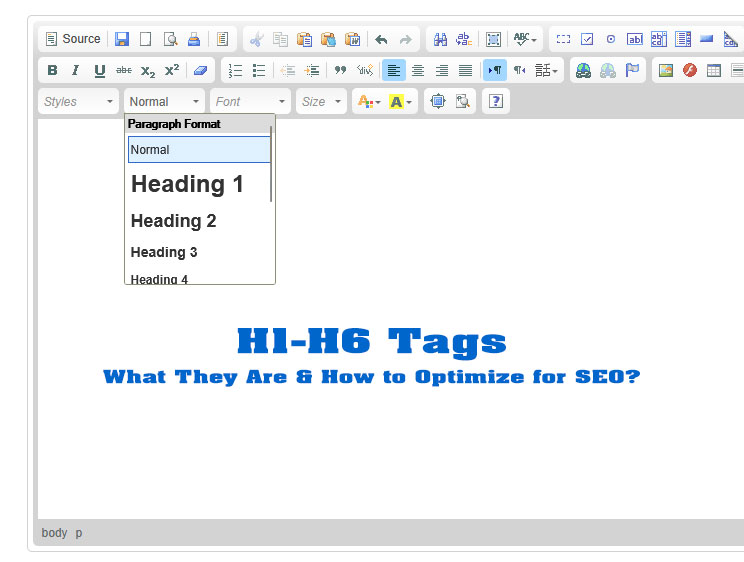What are H tags? How to use H tags properly in an SEO-optimized article
In this article, we’ll dive into the concept of H tags, their role in SEO, and detailed instructions on how to implement them properly. Whether you're new to content writing or a seasoned SEO expert, this guide will provide essential and practical knowledge to help you improve your writing quality and boost your rankings on Google.
What Is a Heading Tag?
Heading tags are HTML elements (from H1 to H6) used to define headings and subheadings in your content, helping both users and search engines understand the structure of a page. Viet SEO agency highlights the importance of heading tags not just for readability, but also for improving your site’s SEO by signaling content hierarchy and keyword relevance.
1. Definition of H Tags
An H tag (short for "Heading") is an HTML tag used to format titles and headings within a web page. There are six levels of H tags, from H1 to H6, in which:
- H1 is the largest and most important heading (usually the main title of the article).
- H2 to H6 are subheadings, used to divide content into sections in descending order of importance.
Example:
<h1>Main Title of the Article</h1>
<h2>Subheading</h2>
<h3>Sub-subheading under H2</h3>
2. The Importance of Heading Tags in Article Structure
H tags not only help format your content clearly but also play a vital role in SEO and readability. When Google or other search engines crawl your content, they use these tags to understand the structure, topics, and main ideas of the article.
The Role of Heading Tags in SEO - According to Viet SEO's research
Heading tags play a crucial role in organizing content and signaling importance to both users and search engines. Proper use of tags like H1, H2, and H3 helps create a clear content hierarchy, making it easier for Google to understand the topic of your page. VietSEO emphasizes that well-structured headings not only improve readability but also enhance SEO performance by supporting keyword placement and user engagement.
1. Helping Search Engines Understand Your Content
H tags act like a roadmap for search engines. When you use heading tags properly, Google can easily determine:
- The main topic of your article (via the H1)
- The key sections of your content (via H2, H3, etc.)
- The hierarchy and relationship between different parts of the content
As a result, your article is more likely to rank higher due to its clear structure and SEO-friendliness.
2. Improving User Experience
A long article without clear section breaks can overwhelm readers. Using heading tags helps your content:
- Look more professional
- Be easier to scan and read
- Allow readers to quickly find the information they need
3. Increasing Visibility in Search Results
Certain headings (especially H1 and H2) can be displayed as featured snippets in search results—especially if they contain well-written, keyword-rich titles. This can significantly boost your click-through rate (CTR).
How to Use H Tags Correctly in Articles
Using H tags correctly is essential for both SEO and user experience. From defining the main topic with an H1 to breaking down content into logical sections with H2s and H3s, each tag serves a purpose. Viet SEO company recommends a clear, consistent heading structure to help search engines crawl your content effectively while making it easier for readers to follow.
1. Golden Rule: One H1 per Article
The H1 is the main title of your entire article—like the title of a book. You should use it only once to define the core topic.
Example:
<h1>What Are H Tags? How to Use Them Properly in Articles</h1>
This should be the only H1 in the article.
2. Use H2 for Main Sections of Content
After the H1, use H2 tags to label each main section. Each H2 should introduce a distinct part of your article.
Example:
<h2>1. What Are H Tags?</h2>
<h2>2. The Role of Heading Tags in SEO</h2>
<h2>3. How to Use H Tags Properly</h2>
3. Use H3, H4, etc., to Break Down Subsections
If your H2 sections contain smaller parts, use H3, H4, and so on to create a logical content hierarchy.
Example:
<h2>3. How to Use H Tags Properly</h2>
<h3>3.1 Best Practices for H1</h3>
<h3>3.2 Dividing Content with H2</h3>
<h3>3.3 When to Use H3 and H4</h3>
4. Include Keywords Naturally
When writing headings, include primary and secondary keywords naturally. Avoid keyword stuffing, which makes headings sound robotic and less engaging.
Good Example:
✅ “Benefits of Using Heading Tags for SEO Optimization”
Bad Example:
❌ “H Tags SEO Optimize H Tag Content SEO Article”
Common Mistakes When Using H Tags
Heading tags are powerful tools for structuring content, but when misused, they can hurt both SEO and user experience. Common mistakes include overusing H1 tags, skipping heading levels, or using them purely for styling. Viet SEO highlights these issues to help you avoid them and create content that’s both well-organized and search engine–friendly.
1. Using Multiple H1 Tags on a Single Page
This is a common mistake, especially when using CMS platforms like WordPress—where some themes or plugins may automatically insert additional H1 tags (e.g., in sidebars or widgets).
Fix: Check the HTML source code or use tools like Screaming Frog SEO Spider to see how many H1 tags exist on your page.
2. Not Using H Tags or Using Them in the Wrong Order
Some writers skip H tags or use them incorrectly (e.g., placing an H3 before an H2). This disrupts content structure and can hurt SEO.
3. Headings That Are Too Long or Too Vague
Headings should be concise, meaningful, and contain relevant keywords. They should also spark curiosity or directly address a reader’s question.
How to Optimize Headings for SEO
Optimizing headings is a key part of on-page SEO that helps search engines understand your content and improves user readability. From crafting clear H1 titles to using H2s and H3s strategically, every heading contributes to your site’s performance. VietSEO agency offers proven techniques to structure headings effectively, enhance keyword relevance, and boost your rankings on Google.
To write SEO-friendly headings, follow these tips:
1. Use Questions in Titles
Question-style titles are popular search queries and often appear in Featured Snippets.
Examples:
- ✅ “What Are H Tags? How to Use Them in Your Articles”
- ✅ “Why Are Heading Tags Important for SEO?”
2. Add Numbers to Your Headings
Numbered titles tend to attract readers because they’re clear and specific.
Examples:
- ✅ “5 Ways to Use Heading Tags to Boost SEO”
- ✅ “7 Common Heading Tag Mistakes to Avoid”
3. Include Target Keywords
Make sure your main keyword appears in your H1, at least one H2, and optionally in H3s if it fits the context naturally.
Tools to Check Your Heading Tags
Use the following tools to audit your heading structure:
- Screaming Frog SEO Spider: Scans your entire website and displays H1, H2, H3 tags, etc.
- SEO Meta in 1 Click (Chrome Extension): Shows all heading tags on a page.
- Ahrefs Site Audit: Checks for missing, duplicate, or incorrectly used heading tags.
Example of a Well-Structured SEO Article with Heading Tags
<h1>SEO Writing Guide for Beginners</h1>
<h2>1. What Is SEO Writing?</h2>
<h3>1.1 Definition</h3>
<h3>1.2 Role in Marketing</h3>
<h2>2. Key Elements of an SEO Article</h2>
<h3>2.1 Keywords</h3>
<h3>2.2 Heading Tags</h3>
<h3>2.3 Meta Description</h3>
<h2>3. How to Optimize Heading Tags</h2>
<h3>3.1 Title Writing Tips</h3>
<h3>3.2 Common Mistakes to Avoid</h3>
Conclusion
Understanding and using heading tags correctly not only helps you organize your article in a logical and reader-friendly way but also significantly enhances your SEO and user experience. Viet SEO company emphasizes that headings are more than just formatting—they’re powerful tools for structure, relevance, and visibility. Don’t underestimate the power of headings—every H tag is a key touchpoint for both your audience and search engines.
If you’re aiming to improve your SEO content writing skills, start with optimizing your headings. It’s a small detail that can make a big difference in your results.



